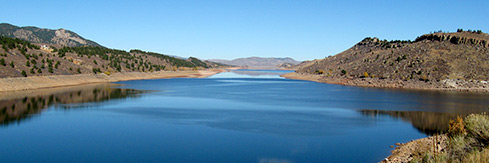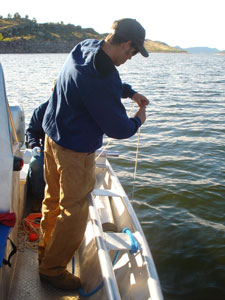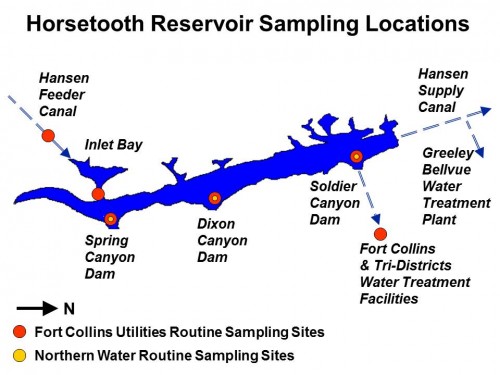Horsetooth Reservoir#


Sampling on Horsetooth Reservoir
Horsetooth Reservoir is an additional high quality water source for the City of Fort Collins. Nearly all Horsetooth Reservoir water comes from the Colorado Big Thompson Project, which is managed and operated by Norther Water. Because of this, the land areas that influence the water quality of Horsetooth Reservoir include watersheds both west and east of the Continental Divide. Water quality in Horsetooth Reservoir reflects the influence of these upstream watershed areas in addition to the relatively small watershed area immediately surrounding Horsetooth Reservoir.
The City of Fort Collins Utilities has been monitoring Horsetooth Reservoir water quality since the early 1980s. In 2015, the City of Fort Collins Utilities and Northern Water entered into a cost-shared agreement to monitor water quality in Horsetooth Reservoir as part of Northern Water’s Baseline Monitoring Program. Horsetooth Reservoir water quality monitoring includes the collection of water samples by boat at three locations seven to 12 times per year. Reservoir monitoring includes the collection of depth profiles for water temperature, pH, dissolved oxygen and specific conductance, and the collection of grab samples. Grab samples are analyzed for nutrients, metals, general chemistry, physical parameters, zooplankton, phytoplankton and chlorophyll.
The City of Fort Collins also monitors water quality in the Hansen Feeder Canal just upstream of where the canal enters Horsetooth Reservoir. FCU routine sampling of the Hansen Feeder Canal includes continuous monitoring with a multi-parameter water quality sonde and the collection of grab samples. Grab sampling is conducted weekly, although not all parameters are analyzed at this frequency.
Data are analyzed and summarized in reports on an annual basis by the City of Fort Collins Utilities. Annual reports also summarize the significant events, regulatory issues, other issues of concern and special studies related to Horsetooth Reservoir.
Did You Know?
After a rain, skipping watering until the grass dries will save not only water, but also money.
Setting your refrigerator to recommended 38-40 degrees Fahrenheit and freezer to 0 degrees Fahrenheit helps save energy.
Using an ENERGY STAR® programmable thermostat or wifi thermostat can help you better control your home's comfort and utility costs.
